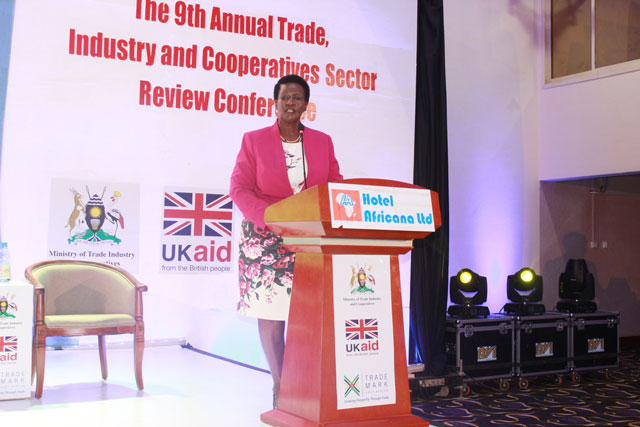
Kampala, Uganda | THE INDEPENDENT | The Ministry of Trade, Industry and Cooperatives is celebrating this year’s export figures, as for the first time in history, Uganda had a favorable balance of trade with Kenya.
Bank of Uganda (BoU) figures indicate that in the Financial Year 2017/18, Uganda had a trade surplus of $122.78 million with Kenya (Exports of $628.47 million against Imports of $505.70 million).
The Central Bank of Kenya (CBK) earlier in the year noted the development in a January-May report, stating that Maize imports from Uganda had played a significant part in the change of fortune.
Uganda also registered a record highest trade balance in the East African Community (EAC) region of $413.86 million (Exports of $1,220.63 million against Imports of $806.77 million), in the same period.

The trade surplus figures were some of the highlights at this year’s annual sector review at Hotel Africana, Kampala on Wednesday. Minister of Trade, Industry and Cooperatives Amelia Kyambadde read out the report, but said despite the big leap in trade balance with Kenya, overall Uganda’s trade deficit grew.
“During the Financial Year under review 2017/18, Uganda’s exports increased by 7.23%, to US$ 2.89 billion from the previous Financial Year 2016/17 of US$ 2.696 billion. Imports also increased by 16.42%, to US$ 5.48 billion from the previous Financial Year 206/17of US$ 4.71 billion,” Kyambadde said, adding that, ” A number of interventions have been made to address the country’s widening trade deficit.”
On the trade deficit, she said that inspite of the challenges, the Trade, Industry and Cooperatives Sector has registered a number of achievements in the area of trade facilitation, export promotion, value addition, cooperative development. “Many of these interventions are geared towards enhancing the capacity of Micro, Small and Medium Enterprises (MSMEs),” she said.
The theme of this year’s sector review was “Enhancing Competitiveness of Micro Small and Medium Enterprises for National Export Development”.
Maize turns the tide vs Kenya
By the time Ugandan farmers complained about low maize prices locally in June and July, the impact on Uganda’s export figures had already been felt in Kenya.
Central Bank of Kenya (CBK) reports earlier in the year indicated that poor weather had seen Kenya increasingly rely on Uganda for its food needs, especially maize and groundnuts. Uganda, the reports indicated, accounted for 70% per cent of the nearly 419,548 tonnes of Kenya’s maize imports.
In January- May, CBK data showed that Uganda accounted for 32.88 per cent of the Ksh91.88b that Kenya paid out to African countries for imports, mainly food products.
Government of Uganda recognised the impact its Maize had (earnings $101 million), and in August agreed to intervene to save the price that had fallen from sh900 to sh200.
Minister Kyambadde told parliament that Government agreed to buy 500,000 metric tonnes of maize from farmers at a minimum price of sh500 to address the low prices on the market.

Coffee remains key
Overall, coffee ($ 492 million) remained the main merchandise foreign exchange earner of the country. In the recent period, its share to total formal exports has however slightly reduced from 18.19% in 2016/17 to 17.04% in 2017/18.
Top of Uganda’s export figure, was followed by gold and gold compounds ($4337 million), then fish and its products. Maize alone raked in $101 million.
“However, the country’s merchandise exports are still dominated by unprocessed and or primary products,” the sector report noted.

The major formal imports were machinery equipment, vehicles and accessories with an import bill of $ 1,081.48 million in 2017/18 representing 23.02% of imported goods composition, which was an increase of 20.08% compared to 2016/17 import bill of $900.61 million representing 22.83%
Petroleum products closely followed at $ 911.04 million (19.39%) in 2017/18, for which it was an increase of 31.31% from $ 693.80 million (17.59%) in 2016/17; followed by chemical and related products; vegetable products, animal, beverages, fats and oil; Base metals and their products.
The individual countries with which Uganda had high trade deficits in 2017/18 were led by China amounting to $854.82 million (representing 32.89% of the deficit); India for $596.96 million (22.97%); Saudi Arabia for $384.07 million (14.78%); United Arab Emirates for $277.74 million (10.69%) and Japan for $247.83 million (9.54%), out of a total deficit of $2,599.10 million in that year. These five countries were responsible for approximately 80% of Uganda’s trade deficit.
“The export to import ratio in the Financial Year 2017/18 was 52.66%,” the sector report indicated, adding that “In other words, today Uganda is spending 100 USD on imports when it has earned an income of only 52.66 USD from exports. In that effect, the country is living on borrowings. It is vitally important to halt this escalation by making reduction of the trade deficit a top national priority and galvanizing all efforts by key MDAs to expand exports on a sustainable basis.”
Interventions
Minister Kyambadde revealed that the sector is employing several strategies to ensure increased value of exports while reducing import values. They include implementation of the National Export Development Strategy (NEDS); Restructuring of the Inter Institutional Trade Committee (IITC) The Ministry is in the process of restructuring the Inter Institutional Trade Committee; Implementation of Buy Uganda Build Uganda Policy; Strengthening Commercial Extension Services in the Local Governments and through market expansion through regional and international trade agreements like that for COMESA.
The COMESA trading bloc remained the main destination for Uganda’s formal exports with the share in total export earnings of 51.32% ($1,483.72 million) in 2017/18, showing an increase of 17.48% from $1,262.94 million in 2016/17; of which Kenya and South Sudan constituted 63.34% ($939.81 million) of the Uganda-COMESA export earnings.
She said several partners were helping the country turn its trade figures. “The Ministry of Trade, Industry and Cooperatives recognises the contribution of all the stakeholders including Government Ministries, Departments and Agencies, Private Sector especially the Business Fraternity, Civil Society, academia and Development Partners among others, for the support offered towards the development of the sector. I wish to thank in particular TradeMark East Africa and UK Aid for the support given to the Sector.”
 The Independent Uganda: You get the Truth we Pay the Price
The Independent Uganda: You get the Truth we Pay the Price



